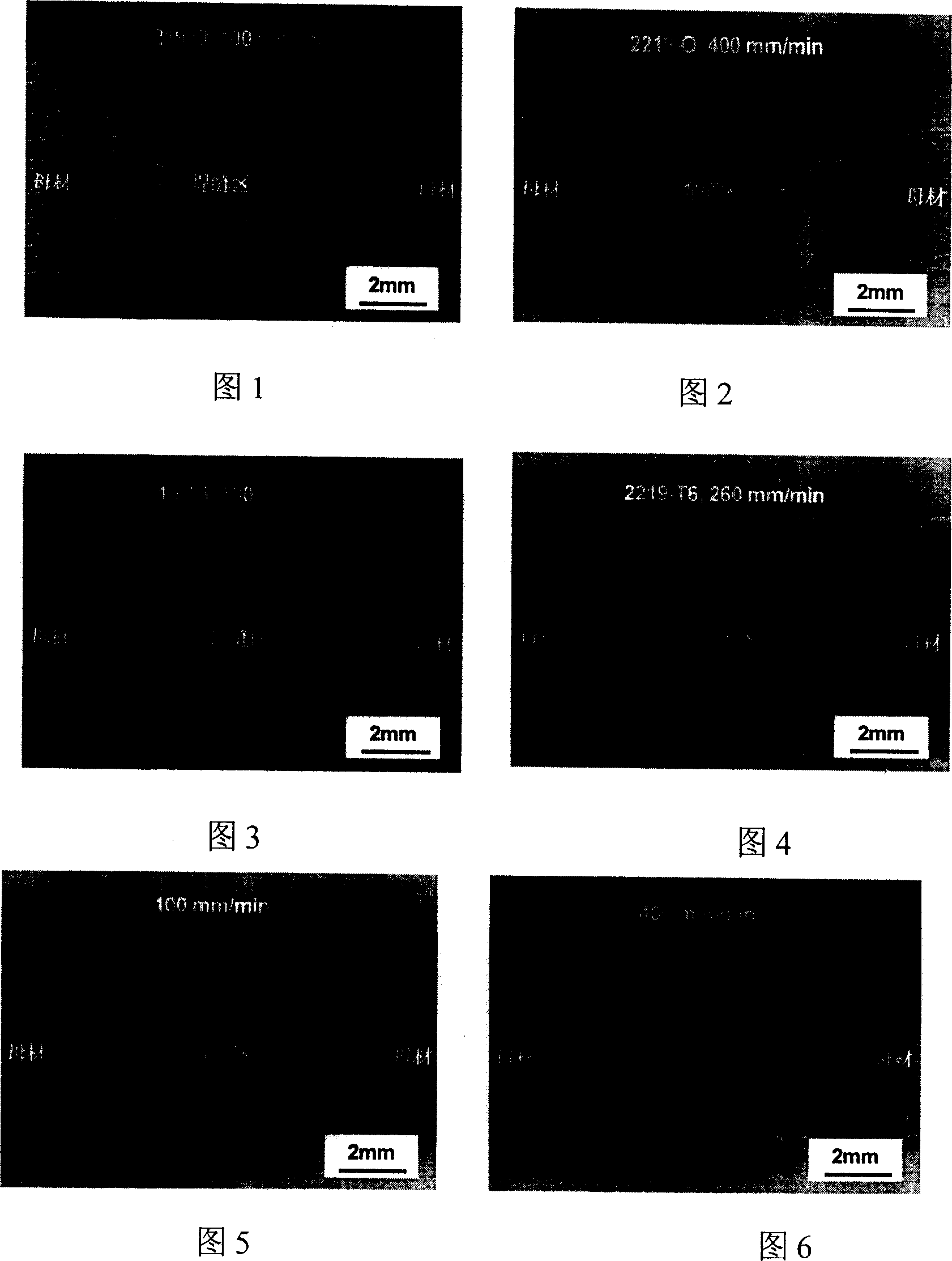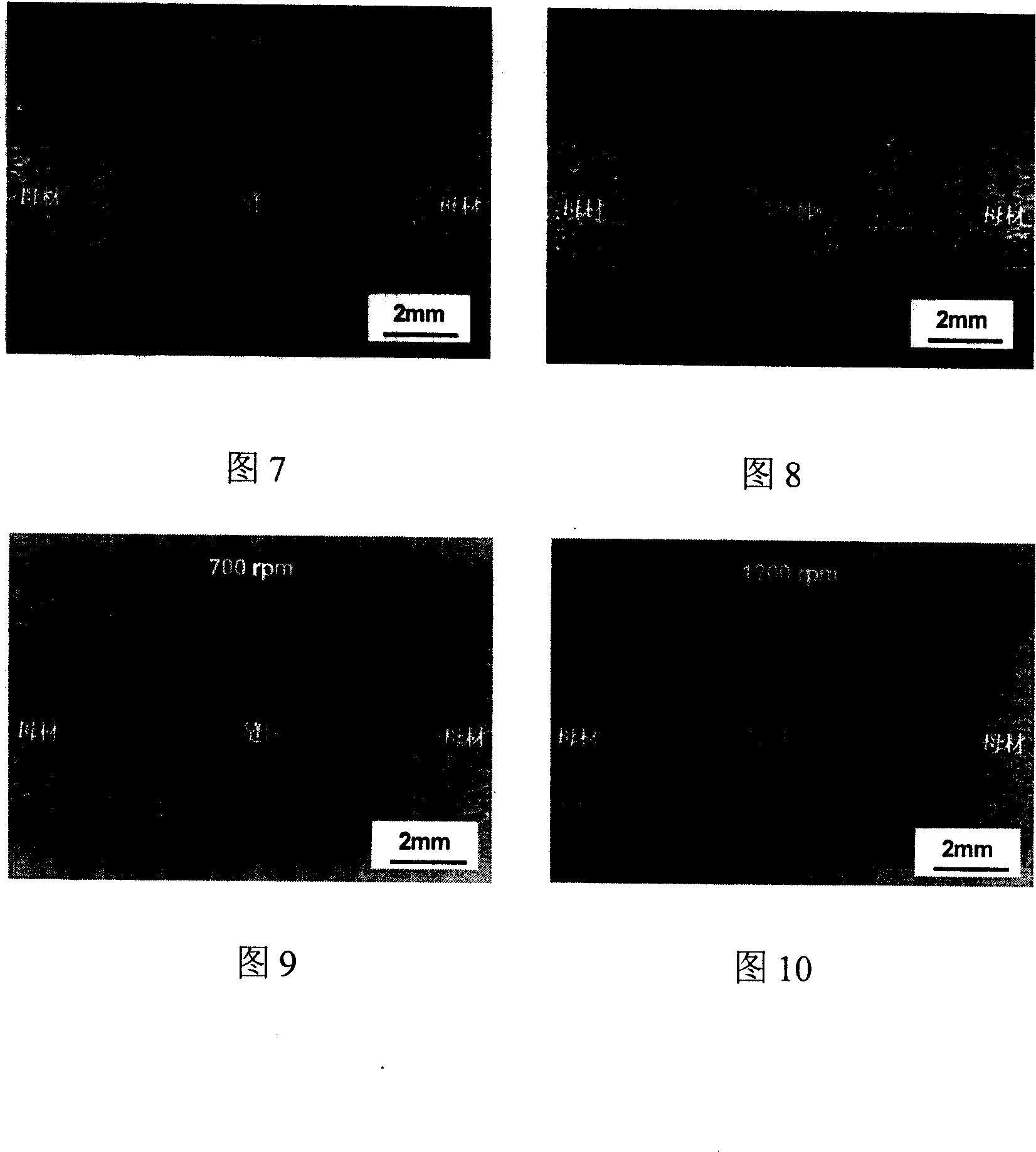Method for preventing aluminum alloy stirring friction welding seam crystal particle from abnormal growth in heat process
A friction stir and aluminum alloy technology, applied in welding equipment, non-electric welding equipment, metal processing equipment, etc., can solve problems that are difficult to implement and affect weld performance
- Summary
- Abstract
- Description
- Claims
- Application Information
AI Technical Summary
Problems solved by technology
Method used
Image
Examples
specific Embodiment approach 1
[0011] Specific Embodiment 1: This specific embodiment is achieved by such a method: first determine the rotational speed of the stirring head, and then, within the range of the welding speed corresponding to the rotational speed of the stirring head, according to the material of the aluminum alloy material to be welded and The size and the type of stirring head determine the selection range of welding speed that does not cause welding defects. Finally, the upper limit of the above range is selected as the welding speed for friction stir welding of the aluminum alloy material to be welded. The aluminum alloy material is an aluminum alloy that can be heat treated. Alloy materials. The above-mentioned non-production of welding defects refers to ensuring that the material is fully plasticized without forming tunnel-type cavity defects in the weld; the rotation speed of the stirring head is in the range of 100 to 6000 rpm; the welding speed corresponding to the rotation speed of th...
specific Embodiment approach 2
[0012] Embodiment 2: The difference between this embodiment and Embodiment 1 is: this embodiment uses 2219-O aluminum alloy as the aluminum alloy material to be welded, its size is 300mm×100mm×5mm, and the joint type is butt joint. A tapered threaded stirring head is used, the shoulder diameter of the stirring head is 14mm (millimeters), the length of the stirring needle is 4.8mm, and the rotation speed of the stirring head is 800rpm (revolutions per minute). At this time, according to the material and The size and the type of stirring head determine that the selection range of the welding speed that does not produce welding defects is 100-400mm / min (millimeters per minute). Therefore, according to the specific embodiment one, the upper limit of the above range is selected as 400mm / min as the welding speed. Friction stir welding of 2219-O aluminum alloy material. Other steps are the same as in the first embodiment. The typical structure of the weld zone of the welded joint of...
specific Embodiment approach 3
[0013] Embodiment 3: The difference between this embodiment and Embodiment 1 is that this embodiment uses 2219-T6 aluminum alloy as the aluminum alloy material to be welded, its size is 300mm×100mm×5mm, and the joint type is butt joint. Tapered threaded stirring head is used, the diameter of the stirring head shaft shoulder is 14mm, the length of the stirring needle is 4.8mm, and the rotation speed of the stirring head is 800rpm. At this time, it is determined that no welding will occur according to the material and size of the aluminum alloy material to be welded and the type of the stirring head. The selection range of the defect welding speed is 100-260 mm / min. Therefore, according to the first embodiment, the upper limit of the above range is 260 mm / min as the welding speed to perform friction stir welding on the 2219-T6 aluminum alloy material. Other steps are the same as in the first embodiment. The typical structure of the weld zone of the welded joint in this specific ...
PUM
| Property | Measurement | Unit |
|---|---|---|
| size | aaaaa | aaaaa |
| size | aaaaa | aaaaa |
| particle size | aaaaa | aaaaa |
Abstract
Description
Claims
Application Information
 Login to View More
Login to View More - R&D
- Intellectual Property
- Life Sciences
- Materials
- Tech Scout
- Unparalleled Data Quality
- Higher Quality Content
- 60% Fewer Hallucinations
Browse by: Latest US Patents, China's latest patents, Technical Efficacy Thesaurus, Application Domain, Technology Topic, Popular Technical Reports.
© 2025 PatSnap. All rights reserved.Legal|Privacy policy|Modern Slavery Act Transparency Statement|Sitemap|About US| Contact US: help@patsnap.com


